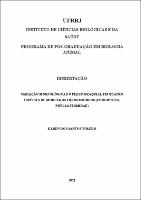| ???jsp.display-item.social.title??? |


|
Please use this identifier to cite or link to this item:
https://tede.ufrrj.br/jspui/handle/jspui/6573| ???metadata.dc.type???: | Dissertação |
| Title: | Variação morfológica do plexo braquial em quatro espécies de morcegos filostomídeos (Chiroptera, Phyllostomidae) |
| Other Titles: | Morphological variation of the brachial plexus in four species of phyllostomid bats (Chiroptera, Phyllostomidae) |
| ???metadata.dc.creator???: | Toledo, Karen dos Santos  |
| ???metadata.dc.contributor.advisor1???: | Peracchi, Adriano Lúcio |
| First advisor-co: | Nogueira, Marcelo Rodrigues |
| ???metadata.dc.contributor.referee1???: | Peracchi, Adriano Lucio |
| ???metadata.dc.contributor.referee2???: | Branco, Érika Renata |
| ???metadata.dc.contributor.referee3???: | Louzada, Nathália Siqueira Veríssimo |
| ???metadata.dc.contributor.referee4???: | Ventura, Adriana |
| ???metadata.dc.contributor.referee5???: | Dias, Daniela |
| ???metadata.dc.description.resumo???: | Apesar das marcantes modificações morfológicas sofridas pelos membros torácicos dos morcegos, informações acerca do plexo braquial desse grupo ainda são escassas. Esse trabalho teve como objetivo descrever a origem, composição e distribuição dessa rede nervosa em quatro representantes da família Phyllostomidae. Para tal, foram dissecados ambos os antímeros de seis Artibeus lituratus, cinco Desmodus rotundus, sete Glossophaga soricina e cinco Phyllostomus hastatus, todos machos adultos oriundos da Coleção Adriano Lúcio Peracchi (UFRRJ). Após a exposição completa da rede nervosa, constatei que o plexo braquial de D. rotundus e P. hastatus forma-se a partir das mesmas raízes (C5 a T1), enquanto o quarto nervo espinhal cervical e o segundo nervo espinhal torácico encontram-se presentes em G. soricina (C4 a T1) e A. lituratus (C5 a T2), respectivamente. Houve variação intraespecífica e assimetria tanto na origem quanto nas combinações dos segmentos nervosos para a formação dos nervos, mas a distribuição para os músculos-alvo e patágios mostrou-se mais conservada. Os dados aqui apresentados suportam a presença de dois padrões de distribuição dos nervos para os músculos em Chiroptera, e a inervação das membranas parece ser explicada pela embriogênese. Embora o plexo braquial dos filostomídeos seja similar ao dos demais Laurasiatheria terrestres, aspectos identificados nesses morcegos, e que parecem ser exclusivos da ordem, podem estar relacionados a características anatômicas dos membros torácicos funcionalmente ligadas ao voo. |
| Abstract: | Despite the remarkable morphological modifications that occurred in the thoracic limbs of bats, information about the brachial plexus in this group is still scarce. This study aimed to describe the origin, composition, and distribution of these peripherical nerves in four species of Phyllostomidae. Both antimers of six Artibeus lituratus, five Desmodus rotundus, seven Glossophaga soricina, and five Phyllostomus hastatus—all males, adults, and from the Adriano Lúcio Peracchi Collection (UFRRJ)—were dissected. After complete exposure of the structure, I found that the brachial plexus of D. rotundus and P. hastatus are formed by the same roots (C5 – T1), while the fourth cervical spinal nerve and the second thoracic spinal nerve are present in G. soricina (C4 – T1) and A. lituratus (C5 – T2), respectively. There was intraspecific variation e asymmetry both in the origin of the structure and in the combinations of the nerve segments for forming the terminal branches. Still, the distribution to the target muscles and patagium was more conserved. Data presented here support the presence of two distribution patterns of the nerves to the muscles in Chiroptera, and the innervation of the membranes seems to be explained by embryogenesis. Although the phyllostomid bats brachial plexus is similar to that of other terrestrial Laurasiatheria, aspects identified in these bats and apparently unique to Chiroptera, may be related to anatomical changes in the thoracic limbs functionally liked to flight. |
| Keywords: | Asas Músculos Nervos Sistema Nervoso Periférico Quirópteros Neotropicais Wings Muscles Nerves Peripherical Nervous System Neotropical Chiropterans |
| ???metadata.dc.subject.cnpq???: | Ecologia |
| Language: | por |
| ???metadata.dc.publisher.country???: | Brasil |
| Publisher: | Universidade Federal Rural do Rio de Janeiro |
| ???metadata.dc.publisher.initials???: | UFRRJ |
| ???metadata.dc.publisher.department???: | Instituto de Ciências Biológicas e da Saúde |
| ???metadata.dc.publisher.program???: | Programa de Pós-Graduação em Biologia Animal |
| Citation: | TOLEDO, Karen dos Santos. Variação morfológica do plexo braquial em quatro espécies de morcegos filostomídeos (Chiroptera, Phyllostomidae). 2021. 56 f. Dissertação (Mestrado em Biologia Animal) - Instituto de Ciências Biológicas e da Saúde, Universidade Federal Rural do Rio de Janeiro, Seropédica, RJ, 2021. |
| ???metadata.dc.rights???: | Acesso Aberto |
| URI: | https://tede.ufrrj.br/jspui/handle/jspui/6573 |
| Issue Date: | 28-May-2021 |
| Appears in Collections: | Mestrado em Biologia Animal |
Files in This Item:
| File | Description | Size | Format | |
|---|---|---|---|---|
| 2021 - Karen dos Santos Toledo.pdf | 2.82 MB | Adobe PDF |  Download/Open Preview |
Items in DSpace are protected by copyright, with all rights reserved, unless otherwise indicated.




